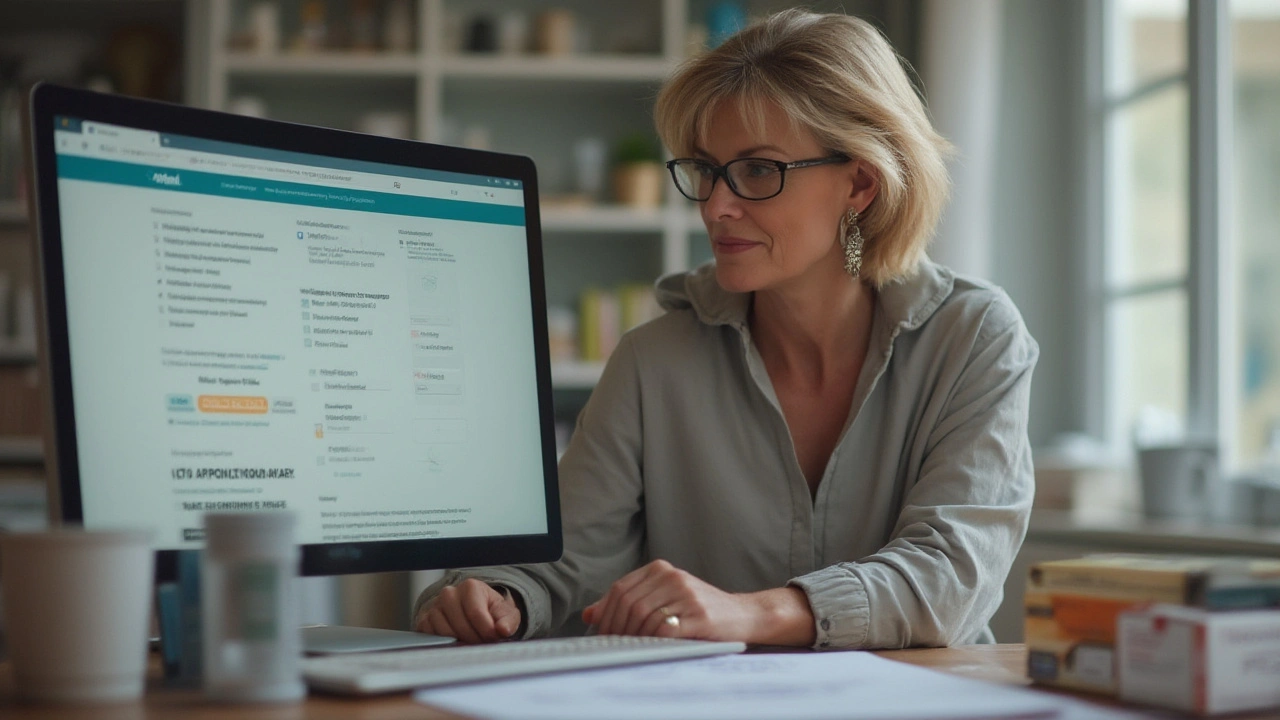Spotting a box of Premarin in a friend’s medicine cabinet isn’t that surprising—after all, this hormone therapy medication has been around since the 1940s. But the way people get it now has totally changed. The old routine of dropping by the pharmacy, prescription in hand, is getting replaced by online ordering. Maybe it’s not glamorous, but let’s face it, nobody really wants to stand in pharmacy lines if there’s a better choice. So, why do so many people switch to buying Premarin online? It’s not just convenience; it’s also about privacy, price, and sometimes necessity. Doctors might write the prescription, but actually getting the medicine—in the right way and from a safe source—requires a little more know-how than just clicking “add to cart.”
Scrolling through page after page of online pharmacies and ads can make your eyes glaze over. And with medications like Premarin that actually matter for your health (think menopause symptoms, hot flashes, bone health... it’s not the kind of thing you want to mess up), getting all the facts becomes so much more important. There’s no shortage of misinformation, either. Some sellers make big claims about how easy and fast it is, glossing over the caveats. Others promise lower prices but don’t mention slow shipping, poor packaging, or even whether the pills are the real thing. Finding what works for you shouldn’t be a guessing game.
What is Premarin and Why Buy Online?
Premarin (conjugated estrogens) has become practically a household name for hormone therapy in menopause. It’s designed to relieve those frustrating hot flashes, vaginal dryness, and prevent osteoporosis—especially in women who’ve gone through menopause or had their ovaries removed. Some doctors also prescribe it for certain hormonal imbalances and even as part of care for transgender women. The pills are most common in 0.3 mg, 0.45 mg, 0.625 mg, and 1.25 mg strengths.
So why is buying Premarin online grabbing so much attention? For some, it’s about avoiding awkward pharmacy visits (especially if the nearest one is a gossip hotspot), but for most, the big draw is convenience. Lots of US and UK pharmacies have shifted their model since COVID—to digital-first, often working with telehealth providers. It’s handy for people who can’t always make in-person doctor appointments or who travel. And yes, some insurance plans require online pharmacies for refills.
Most people think online orders just mean overnight shipping. Actually, timelines can vary a lot. Reputable sites usually offer standard shipping (typically 3–7 days in the US, longer internationally), next-day delivery for an extra fee, and reminders for refills by email or text. The downside: the risk of accidentally using fake pharmacies. According to a 2023 survey by the National Association of Boards of Pharmacy (NABP), less than 5% of online pharmacies reviewed actually met US safe practice standards. That’s a little scary.
Another thing? Prices online can be all over the place. Sometimes it’s double what you’d pay at your local store, but price-matching is becoming more common. Some big-name pharmacies (think Walgreens or CVS online, or Boots in the UK) let you use coupons, FSA/HSA accounts, and even loyalty points. Just be wary—if you see genuine-seeming Premarin for way, way less than expected, that’s a huge red flag.
How to Spot Legitimate Online Pharmacies for Premarin
Here’s the million-dollar question: how do you know the pharmacy is real? Those stories about people getting sugar pills or random supplements instead of actual medication are real. The FDA and NABP both report thousands of scam sites every year. Chemists in Australia and Europe have their own regulatory authorities (like the MHRA in the UK or Medsafe in NZ) that register legit online pharmacies, but plenty of unregistered sellers pop up in Google Ads all the time.
Here’s what to look for to avoid getting scammed:
- Prescription required: Any pharmacy selling Premarin should ask for a real prescription from a licensed provider. If they don’t, big alarm bells.
- Accreditation: Look out for seals like VIPPS (Verified Internet Pharmacy Practice Sites) in the US or GPhC registration in the UK. These aren’t foolproof but help weed out obvious scams.
- Licensed pharmacists: Legit sites always have customer support with real, qualified pharmacists. You should be able to talk to one if you have questions.
- Clear contact info: You should easily find a company address (not just a PO box), phone, and verified email.
- User reviews: Real pharmacies are reviewed on independent platforms like Trustpilot. Ignore reviews on their own site; look elsewhere.
Here’s a comparison of key checks in table form:
| Feature to Check | Legit Pharmacy | Unreliable Pharmacy |
|---|---|---|
| Requires Prescription | Yes | No |
| Physical Address | Visible, verifiable | Missing/fake/PO Box |
| Accreditation | VIPPS, NABP, GPhC | None or fake logos |
| Pharmacist Consult | Offered | Absent/unavailable |
| User Reviews | On third-party sites | None or fake-looking |
| Price | Market rate, transparent | Too low or unclear |
Scammers don’t just hide behind sketchy websites. Some boost their fake pharmacy ads through search engines or spam emails. If you’re feeling rushed or the prices look way off, hit pause and check the seller’s credentials again.

Ordering Premarin Online: Step‑by‑Step Tips and What to Expect
Okay, so you’ve found what looks like a trustworthy pharmacy. The process is straightforward, but first-timers still run into detours that can be a hassle. Here’s how to do it right:
- See your provider (either in person or via telehealth). In most places, starting Premarin for the first time requires a checkup and prescription. Your doctor will ask about symptoms, health history, and may run blood tests.
- Choose your online pharmacy. Look for one that accepts your insurance, if possible, and check for approved accreditation certificates.
- Upload or share your prescription. Some pharmacies will connect directly to your doctor’s office—it saves hassle.
- Select your dosage and package size. Premarin pills come in several strengths and blister pack sizes. Your prescription should specify this, but some sites help you double-check.
- Fill in your contact, shipping, and payment details. Major online pharmacies encrypt this info, but don’t enter it on websites that look sketchy or lack ‘https’ in the address.
- Double-check order confirmation. Reputable sites send a confirmation email with details about your order, pricing, and expected delivery window.
- Track your shipment. Many pharmacies share tracking so you know when to expect delivery. If there’s a delay, they should notify you.
- Read the label and check pills when they arrive. Your Premarin should arrive in sealed packaging, with the manufacturer’s label and dosing instructions. If it looks wrong—different color pills, odd smell, no English labeling—contact the pharmacy and your doctor before taking anything.
Some other stuff to keep in mind: online pharmacies follow state and country laws, so there might be restrictions based on where you live. For example, in some US states, out-of-state pharmacy shipping requires an extra verification step. In countries like Germany, only a handful of approved online chemists exist. International shipping can also be a pain due to customs checks or different packaging rules.
Returns and refunds for prescription drugs work differently than with clothes or gadgets. Most pharmacies don’t accept returns once a prescription drug is shipped, unless there’s a recall or a packaging error, so double-check everything before buying.
For regular users, auto-refill options can help you avoid missed doses. Some pharmacies offer this and will even text you ahead of time—or give discount pricing for larger supplies. If you’re shy about delivery, stealth packaging (plain boxes with no big pharmacy logos) is almost always an option with online sellers. Handy if you live with curious roommates or family.
Risks, Safety, and Smart Shopping Tips
Buying medication online isn’t risky if you use the right pharmacy, but there are downsides worth knowing. The most obvious: fake or substandard drugs. The World Health Organization estimates that about 1 in 10 medical products in developing countries are fake or subpar, and even the US and Europe see thousands of counterfeit seizures each year. Sometimes, these fakes are empty; sometimes, they contain dangerous other substances.
The privacy piece matters, too. Real pharmacies follow HIPAA guidelines in the US or GDPR in Europe, so your medical info isn’t floating around the internet. Shady sellers, though, may leak or sell your details. Sticking with established names, even if the price is a bit higher, usually brings better security.
Payment is another clue. Good pharmacies let you pay with credit cards, sometimes FSA/HSA cards, and Paypal. If you get pushed toward wire transfers, Western Union, or cryptocurrencies, pause right there. Those are classic hallmarks of scammy sellers.
If you’re struggling to afford your medication, don’t go bargain hunting on unknown websites—try patient assistance programs from larger pharmacy chains, manufacturer coupons, or government-backed schemes. Some legit online pharmacies have dedicated social workers who’ll help run eligibility checks for discounts.
For anyone worried about getting help if something goes wrong (like side effects, missed deliveries, or needing an urgent refill), check if the online pharmacy offers 24/7 support. Major chains do, as do most telehealth platforms.
One last tip: be careful with recurring subscriptions. They sound convenient, but fees or restocking schedules can surprise you. Always read the fine print, and set phone reminders to track when you should expect deliveries—especially if refills are essential to managing tough symptoms.
Bottom line? If you do your homework, buying Premarin online can actually save you time, hassle, and sometimes money. The biggest win is comfort—no crowds, no awkward questions, just a few smart clicks and your medication delivered right to your door. But staying safe and informed is what matters most. The peace of mind? Totally worth it.
